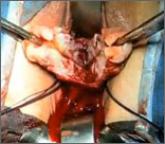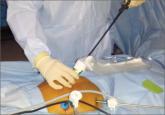Video
Enclosed morcellation using a large bowel isolation bag
This technique is K. Anthony Shibley, MD's, short-term surgical solution to performing closed power morcellation. His patented pneumoperitoneum...
Deborah Reale, Managing Editor

There are still concerns about the plausibility, safety, and efficacy of in-bag morcellation
A 16-month multicenter study in which 73 patients underwent morcellation of the uterus or myomas within an insufflated isolation bag during minimally invasive (MI) hysterectomy or myomectomy recently has been published in Obstetrics & Gynecology. The researchers conclude that contained power morcellation using this technique is feasible.1
Sarah L. Cohen, MD, MPH, and colleagues at Fairview Ridges Hospital, Burnsville, Minnesota; Johns Hopkins Hospital, Baltimore, Maryland; Massachusetts General Hospital, Boston; and Brigham and Women’s Hospital, Boston, Massachusetts are all high-volume surgeons experienced in advanced MI gynecologic surgical techniques.1
Patients in whom morcellation was planned at the time of MI hysterectomy or myomectomy during the study period (January 2013 through April 2014) were offered in-bag morcellation and included in the study. Exclusion criteria were known or suspected malignancy. Preoperative testing was performed to evaluate risk of genital tract cancer. Perioperative information included mode of access, type of procedure(s) performed, operative time, estimated blood loss, specimen weight, intact status of isolation bag postmorcellation, length of hospital stay, intraoperative complications, postoperative complications, readmission, and reoperation.1
The technique for morcellation within an insufflated isolation bag was developed by one of the authors, Tony Shibley, MD, for use during laparoendoscopic single-site hysterectomy (WATCH Dr. Shibley’s technique video here and listen to an interview with Dr. Shibley here.) The technique adapts to multiport laparoscopic and robot-assisted laparoscopic hysterectomy and myomectomy.1
Based on the results of their study, the authors conclude: “Morcellation within an insufflated isolation bag is a feasible technique. Methods for morcellating uterine tissue in a contained manner may provide an option to minimize the risks of open power morcellation while preserving the benefits of minimally invasive surgery.”1
In response to this study, Charles R. Rardin, MD, Associate Professor of Obstetrics and Gynecology at Brown Medical School and Women and Infants’ Hospital in Providence, Rhode Island, wrote an online editorial in Obstetrics & Gynecology.2 Dr. Rardin pointed out that “Until there are more effective screening tools to detect these unusual cancers [leiomyosarcoma], surgeons and hospitals are required to develop responses to these issues.”
He suggests that one extreme reaction to the morcellation crisis is to ban any method of morcellation entirely, leaving laparotomy as the only option for tissue extraction. Finding that logic faulty—relative value to the few at greater cost to the many—he suggests that one might also question the safety of other strategies to treat leiomyomas, including ablation and embolization.
Institutions have responded in several different ways, he says:
He finds that Cohen and colleagues’ techniques lack formal investigation of bag integrity or tissue spread (as successful control of tissue spread was judged by a visual assessment by the surgeon). He also indicates that the technique described is better suited to single-port laparoscopy than multi-port, that single-site laparoscopy required additional training and skill, and that the incisions in single-site laparoscopy are fewer in number but larger in diameter, eliciting concern for increased hernia formation. The authors recognize that using the technique in multi-port surgery, because penetration of the bag by one or more trocars may cause a disruption in bag integrity, is in violation of the manufacturer’s recommendations.1,2 Dr. Rardin additionally expresses concern about “the passage of trocars through the peritoneal cavity, out of direct visualization until the trocar pierces the bag”2 where the camera resides. He is concerned about reducing one set of risks while increasing other risks, and suggests that vaginal hysterectomy would reduce the risk of dissemination while preserving the patient’s benefits from minimally invasive surgery.2
This technique is K. Anthony Shibley, MD's, short-term surgical solution to performing closed power morcellation. His patented pneumoperitoneum...

Dr. Shibley discusses a novel strategy he has developed to address the problem of tissue dispersion during open power morcellation
The decision is the first of its kind by an insurance company and affects BCBS customers in three US states who will no longer be covered if...
James D. Kondrup, MD, demonstrates his surgical team's approach to morcellation, with use of a morcellation bag after laparoscopic supracervical...

Poor visualization is a criticism of large specimen removal through a minimally invasive approach. This technique improves visualization while...
